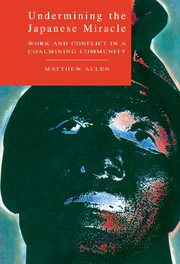Book contents
- Frontmatter
- Contents
- List of Plates
- List of Maps
- List of Figures
- Acknowledgements
- Glossary
- List of abbreviations
- Notes on translation and anonymity
- Map 1
- Map 2
- Introduction
- 1 Chikuho: A Short Description
- 2 The Chikuho Revivalists
- 3 Idegawa
- 4 A Short History of Coalmining: Chikuho in Context
- 5 The Picture Show Man
- 6 A Culture of Violence
- 7 H-san Mine: Violence and Repression
- 8 The Bathing Master
- 9 Labour Conflict: The Case of the K-san Union Action
- 10 D-san and the Students
- 11 Mizuno
- 12 The Y-san Disaster
- 13 Sono
- 14 Welfare
- 15 Welfare in Chikuho
- 16 A Yakuza Story
- Conclusion
- Bibliographical Essay
- Bibliography
- List of Informants
- Index
- Plate section
1 - Chikuho: A Short Description
Published online by Cambridge University Press: 28 October 2009
- Frontmatter
- Contents
- List of Plates
- List of Maps
- List of Figures
- Acknowledgements
- Glossary
- List of abbreviations
- Notes on translation and anonymity
- Map 1
- Map 2
- Introduction
- 1 Chikuho: A Short Description
- 2 The Chikuho Revivalists
- 3 Idegawa
- 4 A Short History of Coalmining: Chikuho in Context
- 5 The Picture Show Man
- 6 A Culture of Violence
- 7 H-san Mine: Violence and Repression
- 8 The Bathing Master
- 9 Labour Conflict: The Case of the K-san Union Action
- 10 D-san and the Students
- 11 Mizuno
- 12 The Y-san Disaster
- 13 Sono
- 14 Welfare
- 15 Welfare in Chikuho
- 16 A Yakuza Story
- Conclusion
- Bibliographical Essay
- Bibliography
- List of Informants
- Index
- Plate section
Summary
The Chikuho region, where this study is based, is situated in the northern central area of Kyushu, Japan's southernmost island. The region lies between Fukuoka city to the south-west and the large industrial cities of Kita Kyushu and Kokura to the north. Chikuho consists of a triangle of three major cities, which in past years were concerned primarily with the production of coal: Nogata to the north, Iizuka to the south, and Tagawa to the east. Lying within imaginary lines joining these three cities are a number of smaller towns that were also primarily coal producing.
Chikuho is situated in what is locally referred to as a ‘basin’ (bonchi), surrounded by mountains. The climate is more extreme than the coastal plains, where the sea breezes tend to be cool in the heat of summer and warm in the winter. Chikuho's geographical position offers little relief from the intense summer heat, and the winters are noticeably colder than in the coastal regions.
Approaching Chikuho from Fukuoka, one drives through the Yakiyama mountains, and from the summit the basin is clearly visible below. The rice paddies dominate the scenery, stretching east toward the Hikosan range and the border with Oita Prefecture, the Onga River winding through the greenery. Iizuka and Tagawa are immediately recognisable by the palls of grey smoke emanating from the cement works and other large industry. The slag-heaps (bota yama), which rise incongruously from the predominantly rural landscape, are coneshaped and perfectly symmetrical, the once-black hills now grassed over, silent testimony to the coal industry's past presence in the area. From the mountains Chikuho looks remarkably green and peaceful. Only the scars of the cities and towns spoil an otherwise idyllic view.
- Type
- Chapter
- Information
- Undermining the Japanese MiracleWork and Conflict in a Japanese Coal-mining Community, pp. 12 - 28Publisher: Cambridge University PressPrint publication year: 1994



